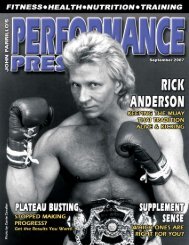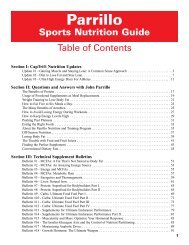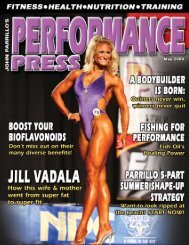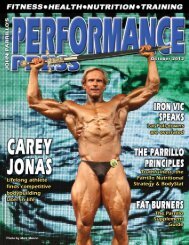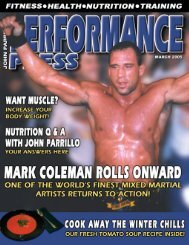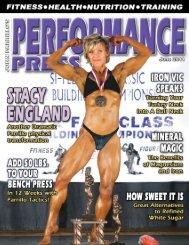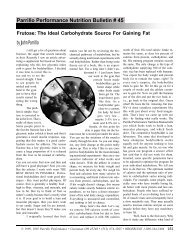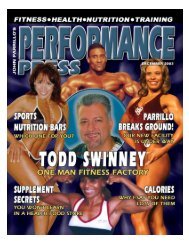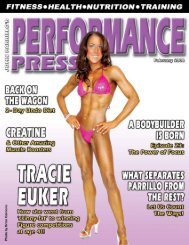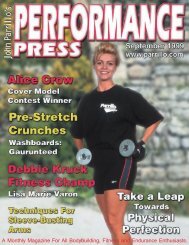Extreme Training Camp - Parrillo Performance
Extreme Training Camp - Parrillo Performance
Extreme Training Camp - Parrillo Performance
You also want an ePaper? Increase the reach of your titles
YUMPU automatically turns print PDFs into web optimized ePapers that Google loves.
JOHN PARRILLO’S PERFORMANCE PRESS<br />
A BODYBUILDER IS BORN: Generations<br />
calories and train as heavy and hard<br />
as possible. Though experts like John<br />
<strong>Parrillo</strong> advise us to keep a steady<br />
amount of cardiovascular training<br />
in our program for general health<br />
as well as to improve the quality of<br />
our weight training and circulation,<br />
the fact is that many bodybuilders<br />
don’t do a lick of cardio in the offseason.<br />
Why burn calories, they<br />
reason, when those calories could<br />
be better used to grow new<br />
muscle tissue? Goals tend to<br />
be set in terms of bodyweight.<br />
“This off-season I want to get<br />
up to 250,” is the type of thing<br />
you often hear. The success or<br />
failure of the off-season training<br />
and nutrition program is<br />
typically measured completely<br />
in terms of bodyweight. If<br />
the person has the discipline<br />
to avoid weighing himself 4-<br />
5 times every day, they will<br />
weigh in at least once a week.<br />
And the higher that number<br />
creeps, the happier that guy<br />
feels about how his off-season<br />
is going. Meanwhile, an equal<br />
or greater amount of fat is being<br />
gained along with any new<br />
muscle mass. And because it’s<br />
accumulating gradually, it’s<br />
so easy to miss the fact that<br />
you are turning into a fat sack<br />
of crap. If you think I am being<br />
harsh, I’ve done this many<br />
times in my own past. Denial<br />
is a powerful psychological tactic<br />
that I have employed over probably<br />
a dozen fall and winter seasons. Reality<br />
comes crashing down every<br />
time, of course. When I can’t button<br />
a pair of size 34 jeans no matter how<br />
much I try to suck my gut in, I know<br />
I’ve gone too far in ‘bulking up’ and<br />
have crossed the line to Fatso Land.<br />
And the real wake-up call is seeing<br />
photos of myself. It’s somehow possible<br />
to look in the mirror and not<br />
see how chunky I have become, but<br />
when some guy that resembles you<br />
except he has a round face and the<br />
beginnings of a double chin is hugging<br />
your lovely wife in a picture,<br />
even I know it’s time to start cutting<br />
back on the bad foods and get back<br />
to more regular cardio. I now refuse<br />
to set arbitrary weight goals of 230<br />
“Who’s that fat guy hugging<br />
on my wife?”<br />
or 240 as I have in the past. From<br />
now on I am adopting the motto of<br />
the great eight-time Mr. Olympia<br />
Lee Haney, who said: “If you can’t<br />
flex it, don’t carry it!” But as long as<br />
you let the numbers on the scale dictate<br />
your progress without regard to<br />
where that increase in bodyweight<br />
is coming from, you too run the risk<br />
of being a chubby off-season mess.<br />
Scenario # 2: The Over-dieted<br />
Stringy Man<br />
Let’s go to the opposite extreme,<br />
which is appropriate since bodybuilding<br />
is all about extremes. Amateur<br />
bodybuilding competitions feature<br />
weight classes. As in any sport<br />
with weight classes, it’s often considered<br />
an advantage to be ‘at the<br />
top of your class.’ So even though for<br />
example, the light-heavyweight division<br />
encompasses anything<br />
over 176 1/4 up to 198 1/4,<br />
nobody ever wants to be near<br />
the lower limit. If they can’t<br />
be in shape at the upper end of<br />
that class, you often see guys<br />
‘suck down’ under 176 1/4<br />
to make the middleweights.<br />
Now they are at the top of that<br />
class, oh boy! Surely they will<br />
fare better than they would<br />
have as a 185-pound lightheavy<br />
up against guys who<br />
were right at 198, right? Not<br />
always, and more often than<br />
not this strategy backfires.<br />
In this theoretical example,<br />
the athlete intentionally lost<br />
a full ten pounds of muscle<br />
mass to make a lower weight<br />
class. He will probably now<br />
be up against shorter, thicker<br />
men and now that he’s lost a<br />
fair amount of lean mass, he<br />
will look stringy and lanky in<br />
comparison. He should have<br />
stopped worrying so much<br />
about how much he weighed and<br />
simply focused on coming in at his<br />
best. Instead, he let the scale mess<br />
with his mind and will probably pay<br />
the price with a lower placing. My<br />
attitude has always been that I work<br />
much too hard to put the muscle on<br />
in the first place, so why would I<br />
ever lose it on purpose? The only<br />
people who this actually makes<br />
sense for are pro bodybuilders in<br />
the 202 division. If they don’t get<br />
down to 202 (soon changing to 212),<br />
their only option is to compete in<br />
the Open class with men as heavy<br />
as 270-280 pounds.<br />
Scenario # 3: Mr. Smooth<br />
aka Mr. Last place<br />
Then there is the opposite to<br />
that situation, and one I have<br />
actually witnessed just as often.<br />
When a bodybuilder has<br />
accumulated a great deal of<br />
bodyfat over the off-season,<br />
it’s often the case that they assume<br />
much more of the weight<br />
they gained was muscle than it<br />
actually was. So let’s say Joe<br />
Meathead competed last year<br />
at 190 pounds, then over the<br />
course of eight months managed<br />
to get his bodyweight up<br />
to 240 pounds. Without really<br />
knowing his body composition,<br />
he will guess that he has<br />
added enough muscle to compete<br />
at the top of the Heavyweights,<br />
or 225 1/4 pounds.<br />
He proudly announces to everyone<br />
that he is moving up a weight class.<br />
He starts dieting, and what do you<br />
know - at eight weeks out from the<br />
show he is down to 225 but is clearly<br />
still not close to being in shape.<br />
Frustrated and confused, he continues<br />
dieting. At four weeks out he is<br />
now 215 pounds but again, far from<br />
being ripped. In reality, he probably<br />
gained enough muscle to compete at<br />
195-198, but he has his heart set on<br />
being a Heavyweight and nothing is<br />
going to stop him. In those final four<br />
weeks, he refuses to do more cardio<br />
or to cut his carbs much, and at the<br />
show he is a smooth 212. With only<br />
blurry definition and a few veins<br />
here and there, he stands on the side<br />
of the stage while the judges call out<br />
the Heavies who showed up with<br />
superior condition. In his mind,<br />
he still believes he is a legitimate<br />
Heavyweight. He will probably repeat<br />
the entire cycle over again, getting<br />
up to a chunky 255 this time<br />
“Never let bodyweight alone<br />
dictate your success.”<br />
and dieting down to a smooth 220.<br />
I have spoken to several bodybuilders<br />
who had a set weight in mind<br />
that they intended to compete at,<br />
and refused to allow themselves to<br />
get much lighter in spite of the fact<br />
that definition is a critical factor in<br />
the judging of any physique competition.<br />
They somehow find satisfaction<br />
at being able to say they competed<br />
at X weight, ignoring the fact<br />
that they should have been X minus<br />
anywhere from 5-20 pounds to be<br />
in contest condition. The scale rules<br />
their world!<br />
The scale is a tool - don’t let it<br />
rule!<br />
Knowing whether your bodyweight<br />
is going up, down, or staying the<br />
same is definitely an important<br />
piece of information. But always<br />
keep in mind that your bodyweight<br />
alone never tells the whole story.<br />
Weight gained can be either muscle<br />
or fat, and the same goes for weight<br />
lost. Even when your bodyweight<br />
doesn’t change, it’s entirely<br />
possible that you have<br />
gained muscle and/or lost fat.<br />
In fact, I have seen many cases<br />
where a person’s bodyweight<br />
hardly changes, but because<br />
they have changed their body<br />
composition drastically (for<br />
the better), they can look like<br />
an entirely different person.<br />
The bottom line is that you<br />
can use the scale as one tool to<br />
gauge the progress of your efforts<br />
towards a physique goal,<br />
but never assume it’s the only<br />
tool you should use. The mirror,<br />
photographs, and of course<br />
some type of reliable bodyfat<br />
measurement are always recommended<br />
to supplement the<br />
scale and provide a complete<br />
and accurate report of the changes<br />
you have made through your training<br />
and diet.<br />
You can get the <strong>Parrillo</strong> BodyStat<br />
Kit for $39.95.<br />
Ron<br />
Harris<br />
is the<br />
author of<br />
Real Bodybuilding,<br />
available at<br />
www.ronharrismuscle.com<br />
12 October 2011 / <strong>Performance</strong> Press 1-800-344-3404 www.parrillo.com www.parrillo.com 1-800-344-3404 <strong>Performance</strong> Press / October 2011<br />
13



